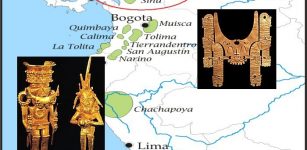Gigantic Karnak Temple Complex: Advanced Ancient Technology In Egypt
A. Sutherland - AncientPages.com - Almost no other site in Egypt is more impressive and fascinating than Karnak.
Karnak Temples at Luxor as seen from the air. Credit: Ahmed Bahloul Khier Galal - CC BY-SA 4.0
Karnak represents one of the most outstanding temple complexes in the world. It results from the combined architectural achievements of several generations of skilled ancient builders of Pharaonic Egypt.
Karnak Was Built With Advanced Ancient Technology
"Construction continued on the temple for thirteen hundred years under approximately thirty different pharaohs. The sheer volume of granite, diorite, and alabaster cut precisely into statues around Luxor attest to the ancient Egyptians' mastery of their craft.
The Greeks and Romans did not sculpt statues in igneous rock," writes Christopher Dunn in his book "Lost Technologies of Ancient Egypt: Advanced Engineering in the Temples of the Pharaohs."
According to Dunn, these achievements would be impossible without taking precise measurements. The unique geometry and precision of ancient Egyptian monuments, structures, and artifacts display incredible symmetry, size, and perfection that, even today, are among the most difficult on earth to obtain.
Karnak, Great Hall. William Henry Goodyear (1846–1923). Credit: Public Domain
Another architectural wonder is an obelisk (one of four that survived) erected by Queen Hatshepsut. It is 97 feet tall and weighs about 320 tons or even more.
Worth noting is that a 'smaller' obelisk was erected by Tuthmosis I (1504 - 1492 BC). It is 75 feet high, has sides 6 feet wide at its base, and weighs between 143 and 160 tons. The inscription at its base informs that cutting the monolith out of the quarry required seven months of labor.
How were these enormous pieces of stone transported from distant Aswan?
Karnak Has Still Not Revealed All Of Its Ancient Secrets
Karnak covers an impressive area of about 3 km (175 miles) and is located north of the modern city of Hatsh. The thriving town of Thebes surrounded it.
The huge obelisk is clearly visible. Credit: Marc Ryckaert - CC BY-SA 4.0
It takes a few hours to walk and look at the historical complex, but it is worth staying until the evening to see the magnificent spectacle of the "light and sound" arranged within the walls of the complex.
The ancient name of this place was "Ipet-Isut" ("The Most Select of Places"). It was the seat of the great god Amun-Re, accompanied by temples and chapels dedicated to other Egyptian deities. It was the main shrine in the land of the pharaohs.
Karnak is considered the largest temple in the world, equaled only by the famous Angkor Wat in Cambodia.
The Karnak Temple Complex, commonly known as Karnak meaning "fortified village", comprises a vast mix of decayed temples, chapels, pylons, and other buildings. Credit: Adobe Stock - alipko
Karnak, which today's name derives from the neighboring village of el-Karnak, is composed of three main compounds. The first, located in the center, is the precinct of Amun-Re with several minor temples; the next is the precinct of Amun's consort, Mut, a self-created goddess "who giveth birth, but was herself not born of any."
To the north is the smallest precinct of Montu, the falcon-headed god of war, "Lord of Thebes." Karnak offers much to see, with a spectacular collection of obelisks, stone statues, gigantic walls, and walls.
One masterwork is the Hypostyle Hall in the Precinct of Amun-Re, a hall area of 50,000 sq ft (5,000 m2) with 134 gigantic columns arranged in 16 rows. One hundred twenty-two columns are 10 meters tall, and the other 12 are 21 meters tall with a diameter of over three meters. The architraves on top of these columns weigh about 70 tons.
Alley of sphinxes. Credit: Janusz Reclaw - CC BY-SA 3
Another one is the 2,700 meters long and 76 meters wide Avenue of Sphinxes, connecting the Luxor and Karnak temples.
Built by the 30th Dynasty king Nectanebo I (380-362 BC), the avenue is lined with several statues depicting sphinxes. On the route of this avenue, Queen Hatshepsut (1473 -1458 BC) built six chapels dedicated to the god Amun-Re and recorded this event in her red chapel in Karnak temple.
Karnak has still not revealed all its secrets; most of the original temple complex is still hidden under the city of Luxor and is inaccessible by archaeologists.
One of many still-kept secrets is what kind of methods builders used to achieve their colossal work.
In 2010, archaeologists unearthed a 3,500-year-old door to the afterlife near the temple in Karnak. Archaeologists believe it is a false door designed to allow the deceased and his wife to interact with the world of the living.
Such niches were found in nearly all ancient Egyptian tombs. The six-foot-tall (1.75 meters) slab of pink granite was decorated with religious texts. The idea was to take the spirits of the dead to and from the afterworld.
Hypostyle hall of the Precinct of Amun-Re, as it appeared in 1838 in The Holy Land, Syria, Idumea, Arabia, Egypt, and Nubia. Image credit: David Roberts RA, artist and Haghe, Louis, 1806-1885, lithographer - Public Domain
The door came from the tomb of User, the chief minister of Queen Hatshepsut, a powerful, long-ruling 15th century BC. Queen from the New Kingdom, a famous mortuary temple near Luxor in southern Egypt.
Built over long construction periods and systematic enlargements from around 2055 BC to 395 AD, Karnak finally lost its power.
In 323 AD, Constantine the Great recognized the Christian religion, and in 356, Constantius II ordered the closing of pagan temples throughout the empire. Karnak was, by this time, mostly abandoned, and Christian churches were built among the ruins. The Festival Hall of Thutmose III still has well-preserved depictions of saints and Coptic inscriptions.
Written by – A. Sutherland AncientPages.com Staff Writer
Updated on January 22, 2022
Copyright © AncientPages.com All rights reserved. This material may not be published, broadcast, rewritten or redistributed in whole or part without the express written permission of AncientPages.com
Expand for referencesMore From Ancient Pages
-
 Malagana Remarkable Sophisticated Goldwork: Legacy Of Colombian Pre-Hispanic Culture
Artifacts | Nov 14, 2018
Malagana Remarkable Sophisticated Goldwork: Legacy Of Colombian Pre-Hispanic Culture
Artifacts | Nov 14, 2018 -
 Image Of The Day: The Inghirami Tomb At Volterra, Italy
Image Of The Day | Sep 9, 2015
Image Of The Day: The Inghirami Tomb At Volterra, Italy
Image Of The Day | Sep 9, 2015 -
 North America’s First Languages Originate From Siberia
Linguistic Discoveries | Apr 10, 2024
North America’s First Languages Originate From Siberia
Linguistic Discoveries | Apr 10, 2024 -
 Surprising Discovery Reveals Why Medieval Graves Were Re-Opened – Stealing Was Not The Purpose
Archaeology | May 24, 2017
Surprising Discovery Reveals Why Medieval Graves Were Re-Opened – Stealing Was Not The Purpose
Archaeology | May 24, 2017 -
 Freemasons Secrets – American Democracy Is Part Of An Ancient Universal Plan – The Beginning And The Dream Of A Brotherhood Of Men – Part 1
Ancient Mysteries | Jul 12, 2018
Freemasons Secrets – American Democracy Is Part Of An Ancient Universal Plan – The Beginning And The Dream Of A Brotherhood Of Men – Part 1
Ancient Mysteries | Jul 12, 2018 -
 Ouroboros – Cosmic Serpent And The Self-Devourer – Universal, Powerful Symbol Of Great Antiquity
Ancient Symbols | Oct 22, 2017
Ouroboros – Cosmic Serpent And The Self-Devourer – Universal, Powerful Symbol Of Great Antiquity
Ancient Symbols | Oct 22, 2017 -
 The Brujo De Chiloé – The Wild Warlocks Of The Chiloé Archipelago
Featured Stories | May 4, 2022
The Brujo De Chiloé – The Wild Warlocks Of The Chiloé Archipelago
Featured Stories | May 4, 2022 -
 Mystery Of Sacred Groves Of Oshogbo And Its Remarkable Ancient Figures
Featured Stories | Nov 25, 2023
Mystery Of Sacred Groves Of Oshogbo And Its Remarkable Ancient Figures
Featured Stories | Nov 25, 2023 -
 Mystery Of Giant Gogmagog’s Hidden Treasure Beneath Castell Dinas Bran
Featured Stories | Jan 23, 2025
Mystery Of Giant Gogmagog’s Hidden Treasure Beneath Castell Dinas Bran
Featured Stories | Jan 23, 2025 -
 Irminsul – Mysterious Sacred Symbol Of The Saxons – Is It Linked To Yggdrasil And God Odin?
Ancient Symbols | Feb 11, 2019
Irminsul – Mysterious Sacred Symbol Of The Saxons – Is It Linked To Yggdrasil And God Odin?
Ancient Symbols | Feb 11, 2019 -
 King David-Era Fort Unearthed In Golan Heights Sheds Light On Aramean Kingdom Of Geshur
Archaeology | Nov 14, 2020
King David-Era Fort Unearthed In Golan Heights Sheds Light On Aramean Kingdom Of Geshur
Archaeology | Nov 14, 2020 -
 Rare 1,000-Year-Old Viking Wooden Bowl Found By Young Boy
Archaeology | Oct 24, 2022
Rare 1,000-Year-Old Viking Wooden Bowl Found By Young Boy
Archaeology | Oct 24, 2022 -
 Large Mammoth Tusk And Bones Buried For Thousands Of Years Found In North Dakota
News | Jan 8, 2024
Large Mammoth Tusk And Bones Buried For Thousands Of Years Found In North Dakota
News | Jan 8, 2024 -
 Secrets Of The Lost Ancient Sahara Civilization
Ancient Mysteries | Oct 26, 2018
Secrets Of The Lost Ancient Sahara Civilization
Ancient Mysteries | Oct 26, 2018 -
 Mysterious Underground City In Brazil Could Re-Write Ancient History – Riddle Of The 12 Men – Part 2
Ancient Mysteries | Jan 26, 2022
Mysterious Underground City In Brazil Could Re-Write Ancient History – Riddle Of The 12 Men – Part 2
Ancient Mysteries | Jan 26, 2022 -
 On This Day In History: Alexander The Great Defeats Darius III Of Persia In The Battle Of The Granicus On May 22, 334 B.C.
News | May 22, 2016
On This Day In History: Alexander The Great Defeats Darius III Of Persia In The Battle Of The Granicus On May 22, 334 B.C.
News | May 22, 2016 -
 Interbreeding With Modern Humans Wiped Out Neanderthals’ Y Chromosomes 100,000 Years Ago
Archaeology | Sep 28, 2020
Interbreeding With Modern Humans Wiped Out Neanderthals’ Y Chromosomes 100,000 Years Ago
Archaeology | Sep 28, 2020 -
 Extraordinary Fossils From The End Of The Age Of The Dinosaurs – Study
Paleontology | Oct 15, 2023
Extraordinary Fossils From The End Of The Age Of The Dinosaurs – Study
Paleontology | Oct 15, 2023 -
 Binary Code Was Used In Ancient India And Polynesia Long Before Leibnitz Invented It
Ancient Technology | Sep 28, 2017
Binary Code Was Used In Ancient India And Polynesia Long Before Leibnitz Invented It
Ancient Technology | Sep 28, 2017 -
 European Neolithic Family Trees Shed Light On Social Organization
Archaeology | Jul 27, 2023
European Neolithic Family Trees Shed Light On Social Organization
Archaeology | Jul 27, 2023






